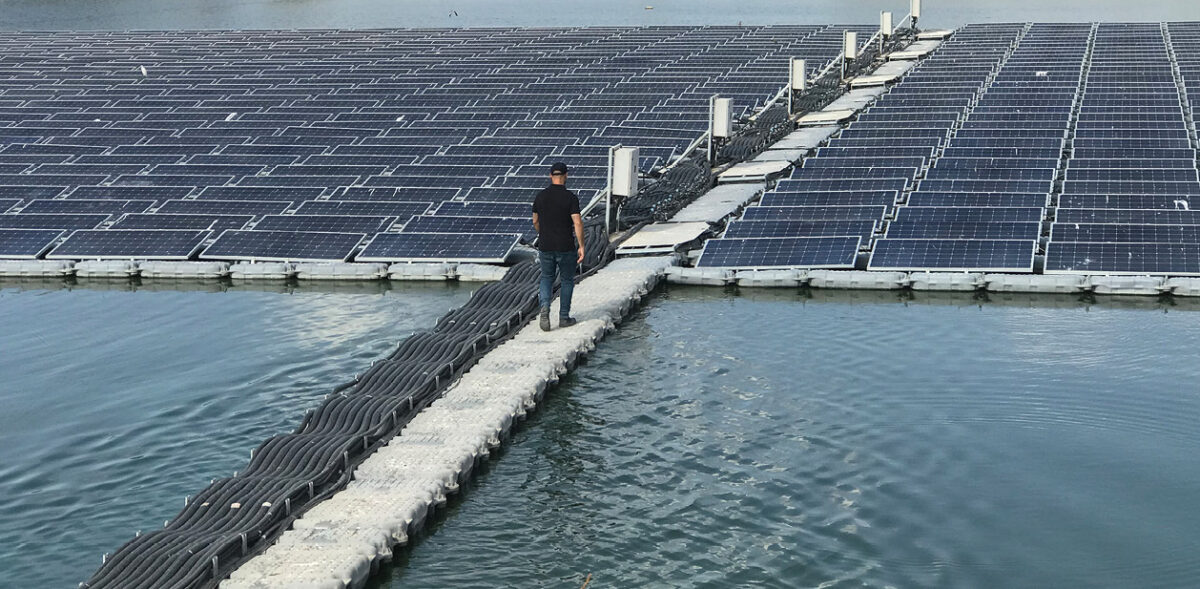An international research team has compiled and reviewed published literature on floating solar photovoltaic (FPV) systems from 2013-2022 and how water-based systems compare to those based on land. The paper summarizes the important findings of a broad range of studies on FPV systems and presents a comprehensive overview of the state-of-the-art of the technology, its benefits and challenges, and highlights research gaps.
The study’s corresponding author, Ramanan Chidambaram Jayaraj, told pv magazine that the team reviewed more than 300 articles, as well as patents, industry websites, and reports. The researchers charted the energy gain in FPV relative to LPV for 19 different reports examining FPV technologies ranging in size and tilt angle, as well as the efficiency gain for 10 different reports. For this report, the team excluded from their review studies that investigated submerged and partially submerged PV as well as systems that were in contact with water for cooling.
“With 70% of the world covered with water, research and development of FPV on ocean platforms opens a new era of solar energy with the advancement of robust floating structures,” the scientists emphasized. “However, it should be noted that oceans are not necessarily calm, and harsh ocean currents may pose serious challenges to FPV structures. Therefore, research and development efforts addressing this issue are crucial.”
The researchers noted that the results of the studies reviewed suggest that the increased energy production capacity from FPVs can potentially result in a decrease of up to 85% in the levelized cost of energy (LCOE) compared to land-based PV (LPV) systems, even despite the higher initial capital investment. Data compiled from the literature showed potential energy yield increases of up to 35.9% for FPV compared to conventional systems. They highlight several factors that affect the ability to achieve this maximum performance, including irradiance level, tilt angle, temperature, and cooling effect, among others.
The team also observed a range between 0.1% and 4.45% for the efficiency gain of FPVs against LPVs, as well as improvements of 2.4% to 3.3% for FPVs employing tracking technology. Additionally, the reviewed studies showed that bifacial floating solar panels that also use dual-axis tracking and cooling effects could even achieve gains of 42.5% to 47.5%.
“Based on the comprehensive review spanning from 2013 to 2022, it has been consistently demonstrated that floating photovoltaic systems outperform conventional land solar PV systems under homogeneous conditions,” they concluded. Additionally, they emphasized that FPV integrated with hydropower dams “not only maximizes renewable energy generation but also capitalizes on existing infrastructure, potentially revolutionizing the energy landscape.”
The study included a discussion of challenges faced by FPV systems, noting that factors such as the varying elevation of land in the pathway of the panels – as well as rocks, grass, and other panels – can influence the effectiveness of wind in cooling the panels. It cites a case where the temperature of an FPV was higher than that of a rooftop system during peak sun hours, emphasizing that performance is “highly dependent” on the system’s location.
The group explained that certain limitations emerged from the analyses reviewed in the study. “The existing techno-economic analyses and predictions on FPV performance often rely on software tools, which offer advantages in terms of cost, time, and resource efficiency compared to traditional research methods,” it said. “However, these software tools often require significant modifications to their user interfaces to adequately accommodate the unique characteristics and requirements of FPV systems. Additionally, some studies have found that even reputable solar PV software may not be fully capable of accurately predicting the performance of FPV systems.”
The results of the review are available in the study “Towards sustainable power generation: Recent advancements in floating photovoltaic technologies – ScienceDirect,” which was published in Renewable and Sustainable Energy Reviews. The team comprises researchers from Malaysia’s Curtin University and India’s Energy Institute Bangalore and Assam Energy Institute.
The researchers stressed that “there is a pressing need for further development of software dedicated to numerical modeling and prediction specifically tailored for FPV applications. This development would enable more accurate and reliable assessments of FPV performance, contributing to the advancement and widespread adoption of the technology in the renewable energy sector.”
This content is protected by copyright and may not be reused. If you want to cooperate with us and would like to reuse some of our content, please contact: editors@pv-magazine.com.




[kicks mud] Nuts, nobody wants to float crazy high and capture all that solar gamma ray goodness. Give those fish some space to jump. Did we also have to jam the first person view abbreviation space? I mean, nobody’s changing their panels to float as opposed to attaching a floating scheme…